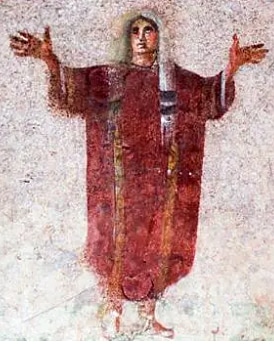(photo above is “Orante,” detail from a fresco in the Catacomb of Priscilla, Rome. Mid-third century.)
By Sister Nancy Liddy
Our closest neighbors in terms of monastic communities lie just across the Kentucky border in Southern Indiana: The Sisters of St. Benedict, and not far from them, the monks of St. Meinrad Archabbey. We Ursulines have always had a relationship with these communities since our beginnings in 1874. I became more familiar with the monks in my years ministering and living at St. Meinrad.
During that time there were many opportunities to meet Benedictine Oblates (the Oblates are a version of our MSJ Associates) and attend Mass together. I remember being struck by the number of comments from Oblates from other Christian traditions on the physicality of the monks at prayer. They shared their appreciation of the long processions, bowing, kneeling, and many other gestures, sights, scents, and sounds of the community liturgies. Reflecting on these conversations helped me to realize as Catholic Christians we can miss the richness of our tradition hidden in plain sight. We lift our minds and hearts in prayer – but our bodies? Perhaps not so much.
Bishop Robert Barron, known by many of our Associates for his smart media presentations of the faith, shared an experience of being touched by the divine at the beautiful Sainte-Chapelle chapel in Paris. He visited the typically crowded Sainte-Chapelle often. Once he found himself there without many people and decided to sit on the floor as a way to “just soak up the spiritual power of the place.” He described his experience as a “charged mystical moment.”
I love the image of this intellectual and physical giant (he’s tall!) lowering himself to the ground to increase his capacity to take in the experience. This is a good example of how a posture of openness can make a difference in our public and private prayer. If movement is a challenge, we can simply remain seated in an attentive silence – even bringing a sore shoulder or stiff neck to the moment.
Occasionally, an elder Sister seated in front of me in our chapel would fling her arms up in praise during the Eucharistic prayer. The theologian Teresa Berger discovered one good thing about Mass online during the pandemic. It was the joy she experienced dancing in her living room as the virtual choir and assembly sang the Gloria. Though I may prefer unity at liturgy, these are beautiful examples of how our bodies are somehow connected with receptiveness to the holy.
Something to Consider
As we continue as a Church to participate in these years of Eucharistic Revival, and enter the season of Advent, in what ways can we engage our bodies and senses to give our full attention to the presence of God?
As part of the Revival, Eucharistic pilgrimages will take place throughout the country this coming year. A pilgrimage is an opportunity to pray with our lungs and our legs!

Comments
Perfect way to get us into advent! Thanks, Sister Nancy!
Thanks for this wonderful reflection, Sr. Nancy. Despite our being nearly 60 years removed form Vatican Council II and the liturgical restoration and renewal, too many of us Catholics still see the liturgy as something we “attend,” or “watch.” In far too many settings we are still more an “audience” than an assembly gathered to do the work of the liturgy. And too many priests are still “saying mass” rather than presiding with a community that celebrates as one body. J. Glenn Murray, SJ used to say that the liturgy should leave us exhausted because we’d worked so hard. In a real sense the liturgical renewal that was the greatest gift of the Council has yet to happen for millions of Catholics. Mass is a verb and not a noun, I would tell my students over the years. Tim Cronin Dayton Oh (Sr. Mary Patrick McDonagh osu’s nephew).
Congratulations ELAINE 💟✝️💟
Thanks for the examples of how our bodies are connected with receptiveness to the holy. It seems some cultures are more expressive than others. For many of us music helps us lift our minds and hearts in prayer as one way among others.
This is an insightful and challenging reflection, Sr. Nancy. I feel encouraged to rock back and forth during the musical parts of the liturgy, more like a little sway but meaningful to me. Thank you.